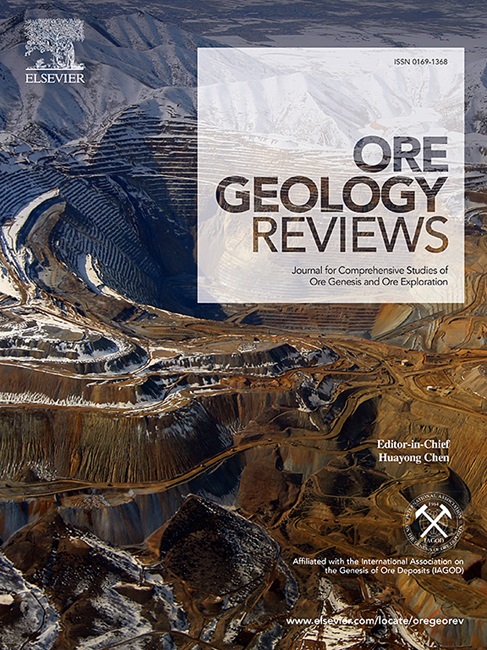塞勒姆花岗岩的岩石成因、岩浆和变质演化:对达马拉造山运动的启示
IF 3.2
2区 地球科学
Q1 GEOLOGY
引用次数: 0
摘要
泛非造山运动在西南非洲达马拉造山带中部引发了广泛的岩浆活动。然而,这些花岗岩复合体的成因仍然是一个相当不确定的主题。塞勒姆花岗岩位于达马拉造山带的中心地带,是研究该造山带构造演化的主要对象。本文采用多学科的方法,包括岩石学、全岩石地球化学、U-Pb年代学,对采自塞勒姆花岗岩杂岩的石英二长岩和花岗闪长岩中的锆石和独一石进行了研究。讨论了岩石成因、岩浆演化和变质演化及其对达马拉造山运动的启示。全岩地球化学资料分析表明,塞勒姆花岗岩主要为过铝质、铁质、碱-钙-碱性质。这些岩石表现出高场强元素(如Th、U、Nb、Zr)浓度升高,轻稀土元素(LREE)相对于重稀土元素(HREE)富集。这些地球化学特征与a型过铝花岗岩相似。岩浆在演化过程中可能经历了斜长石、黑云母和石榴石的分馏作用。锆石和独居石U-Pb数据显示岩浆结晶年龄为539 ~ 538 Ma,与达马拉造山带540 ~ 490 Ma的岩浆活动重叠。528 ~ 526 Ma的变质年龄与530 ~ 520 Ma区域麻粒岩相变质高峰相一致。这些花岗岩的变质年龄为501 ~ 484 Ma,与造山后岩浆作用的时间和500 ~ 480 Ma的铀矿化年龄一致。其Nb/Ta值(19.0 ~ 71.2)和Zr/Hf值(83.5 ~ 146.0)明显高于贫地幔(Nb/Ta = 17.5, Zr/Hf = 36.3)和地壳(Nb/Ta = 12.4, Zr/Hf = 35.5),表明岩浆可能来源于富集地幔。Pb、Rb、K等大离子亲石元素的存在表明幔源岩浆在上升过程中与地壳物质相互作用。本文认为,塞勒姆花岗岩的岩浆源主要来自地幔,在刚果克拉通和卡拉哈里克拉通大陆碰撞过程中受到地壳物质的污染。本文章由计算机程序翻译,如有差异,请以英文原文为准。

Petrogenesis, magmatic and metamorphic evolution of Salem granite: Implications for the Damara Orogeny
The Pan-African Orogeny induced extensive magmatic activity in the Central Zone of the Damara Orogenic Belt in Southwest Africa. However, the genesis of these granitoid complexes remains a subject of considerable uncertainty. The Salem granite, situated within the Central Zone of the Damara Orogenic Belt, serves as a prime subject for the investigation of the tectonic evolution of this belt. This paper utilizes a multidisciplinary approach encompassing petrography, whole rock geochemistry, U-Pb geochronology on zircon and monazite from quartz-monzonites and granodiorites collected from the Salem granitic complex. It discusses the petrogenesis, magmatic and metamorphic evolution, as well as its implication for the Damara Orogeny. The analysis of whole rock geochemical data suggests that the Salem granite are primarily peraluminous, ferroan, and alkali-calcic to alkalic in nature. These rocks exhibit elevated concentrations of high field strength elements (e.g., Th, U, Nb, Zr) and demonstrate light rare earth elements (LREE) enrichment relative to heavy rare earth elements (HREE). These geochemical characteristics bear a resemblance to those observed in A-type peraluminous granites. The magma may have undergone fractionation of plagioclase, biotite, and garnet during its evolution. Zircon and monazite U-Pb data reveal a magma crystallization age of 539–538 Ma, which overlaps with the extensive 540–490 Ma magmatic activity in the Damara Orogenic Belt. Their metamorphic age of 528–526 Ma is consistent with the 530–520 Ma regional peak granulite facies metamorphism. The metamorphic age of 501–484 Ma these granites coincides with the timing of the post-orogenic magmatism and uranium mineralization age of 500–480 Ma. Their Nb/Ta (19.0–71.2) and Zr/Hf ratios (83.5–146.0) are significantly higher than those of the depleted mantle (Nb/Ta = 17.5, Zr/Hf = 36.3) and crust (Nb/Ta = 12.4, Zr/Hf = 35.5), suggesting that the magma may source from an enriched mantle. The presence of large ion lithophile elements such as Pb, Rb and K indicates that the mantle-derived magmas interacted with the crustal material during their ascent. We propose that the magma source of Salem granite was primarily derived from the mantle and was subsequently contaminated by crustal materials during the continental collision of Congo Craton and Kalahari Craton.
求助全文
通过发布文献求助,成功后即可免费获取论文全文。
去求助
来源期刊

Ore Geology Reviews
地学-地质学
CiteScore
6.50
自引率
27.30%
发文量
546
审稿时长
22.9 weeks
期刊介绍:
Ore Geology Reviews aims to familiarize all earth scientists with recent advances in a number of interconnected disciplines related to the study of, and search for, ore deposits. The reviews range from brief to longer contributions, but the journal preferentially publishes manuscripts that fill the niche between the commonly shorter journal articles and the comprehensive book coverages, and thus has a special appeal to many authors and readers.
 求助内容:
求助内容: 应助结果提醒方式:
应助结果提醒方式:


